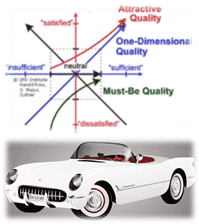 Many people wrongly assume that so-called Kano model (diagram on the right) describes the relationship between customer needs, fulfillment of product features, and satisfaction.
Many people wrongly assume that so-called Kano model (diagram on the right) describes the relationship between customer needs, fulfillment of product features, and satisfaction.The1984 research, "Attractive Quality and Must-Be Quality" by N. Seraku, F. Takahashi, and N. Kano, Ph.D., measured satisfaction merely against the existence or absence of a feature. It did not and does not address customer needs.
Additionally, the Kano categories came from customer survey responding to inverse-paired questions. They were not and are not assigned by product engineers or producers.
The most serious error that people often make is the misleading "curved-arrow" that is often cited as shown in the above diagram. The inverse-paired question yields only two data points: the "if" and the "if not". You can only draw a line (= linear) with two data points. It takes three data points to inscribe a curve! This is why Glenn Mazur (QFD Institute), who translated Kano's original Japanese paper into English over two decades ago, wonders how many people who cite the Kano model actually read their study.
 This problems was addressed by Mr. Harold Ross, a now retired General Motors engineer and a director of the QFD Institute. He called this the New Kano Model, which adds the necessary questions to draw the "curve" and use it to reveal hidden market segments and extrapolate better design decisions.
This problems was addressed by Mr. Harold Ross, a now retired General Motors engineer and a director of the QFD Institute. He called this the New Kano Model, which adds the necessary questions to draw the "curve" and use it to reveal hidden market segments and extrapolate better design decisions.Using the Modern QFD tools that are taught in the QFD Black Belt® course, you can then identify the invisible, moving target of customer satisfaction that the original Kano model does not address.
This new methodology will be presented at the 26th Symposium on QFD, December 5, 2014 in Charleston, South Carolina USA. It will include implementation examples of automotive industry, development of marketing and advertising content, as well as identifying clearer performance targets for each customer segment.
Everyone is welcomed at this symposium, regardless of your QFD knowledge.
Here is how to attend.